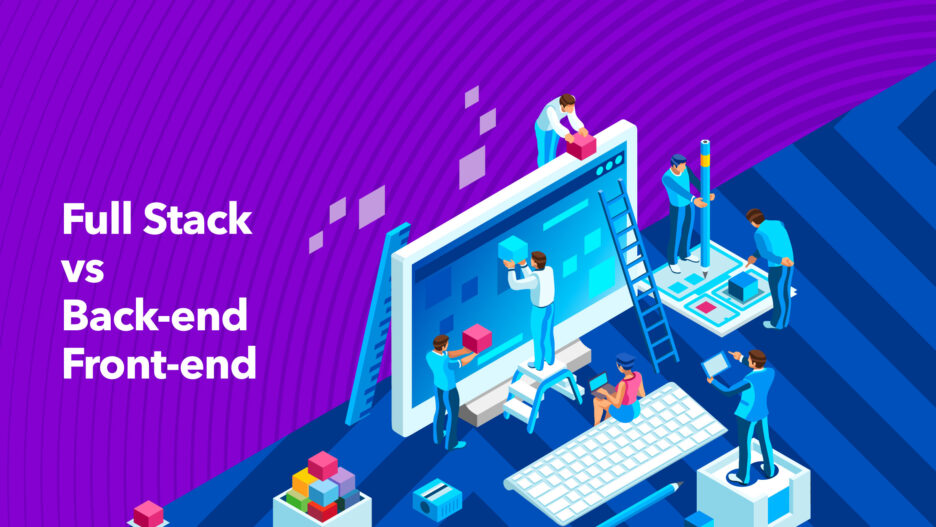Full Stack. Back-end. Front-end. Well, that’s a mouthful. But that’s not where complexity ends, as there’s more under the hood for each of the three available types of web programming development. In a world that increasingly demands new content, applications, and software at break-neck speed, developers need to continuously drive different aspects of the build process to ensure applications are being deployed with quality. For all of this to happen, full stack, back-end, and front-end developers play key roles in web programming, each with unique responsibilities that address specific areas of the development process. In this blog post, we’re going to dissect each one, giving you a full-frontal view of what the responsibilities are, as well as list out the advantages of each one. As a spoiler, we’ll say that full stack is a general programming practice, while back-end and front-end are more specialized. Let’s get going!
What is back-end development
Much like in a movie, there’s more that meets the eye than what you see up on the screen. In fact, there are hundreds of people working behind the scenes to make the magic come alive, from producers, costume designers, the director, photography experts, special effects specialists, and more, so it really takes a village, as the saying goes. Well, when talking about web programming, there’s a lot going on behind the scenes and that’s called the back-end.
Back-end development, also known as server-side development, refers to all the development that takes place for backdoor activities in a website. For example, let’s say you click on an item inside a website, and it leads you to a submission form; for that to happen, there are specific commands, code and software involved to get you there, and those backdoor activities are what back-end developers are in charge of developing.

Back-end development mostly deals with database, logic, APIs, and servers. Back-end developers create the code that makes each of these items communicate seamlessly, making data flow between the browser and the database. Let’s go back to that form submission example. When you click on the Submit button, the information you provided is sent to a server where it’s processed and then sent to the database for storage. As an end user, you won’t be seeing any of this happen, in fact, you’ll hardly ever think about this process. But it’s all there, working diligently behind the curtains so that you have a seamless experience.
Back-end developers are responsible for building a software application’s foundation and structure. Most development teams have both back-end and front-end developers, collaborating to create a fully realized software product. The back-end developer’s arsenal consists of different tools among which we can find server-side languages like Java, PHP, Python, Ruby, NodeJS, and .NET, to name a few. Other tools include MySQL, MongoDB, SQL, and more, all with the goal of serving data to the front-end of the application.
What is front-end development
In movies, you are impressed with what you’re seeing on your screen. The scenery, the effects, the actors, it all adds to the experience. Same with software applications, where the front-end is what you see and experience as an end user. Front-end development, also referred to as client-side development, is the practice of creating HTML, CSS, and JavaScript elements for a software application, so end users can interact and engage with. In short, it’s the interface the user sees and where they can perform diverse actions like clicking, submitting, filling out details, and more. The front-end of a website involves a series of dynamic elements, from fonts, colors, drop-down menus, sliders, and more, it’s all the collective effort of HyperText Markup Language (HTML), Cascading Style Sheets (CSS), and JavaScript as stated earlier., which are the three main programming languages that front-end developers must master.
Front-end developers are in charge of a website’s user facing code as well as the architecture of user experiences, and in addition to the above-mentioned languages, they’re typically familiar with Bootstrap, Backbone, AngularJS, ReactJS, jQuery, and EmberJS, to name a few. Great looking and easy to use content is what it’s all about, because even though you can have a high functioning software system in your hands, the truth is that, if it doesn’t look appealing or interesting, users won’t want to use it. Let’s crack down each of the cornerstone front-end creation web development tools.
The CSS language controls how the website will look as it sets fonts, colors, page layout options, background, and more. It’s used to dictate how a document will look like that was written using a markup language like HTML. HTML, for which the most recent version is HTML5, is the framework upon which the website will be built. It helps developers create the content and structure of a website. It is the standard markup language that’s used to create websites and online applications. These two wouldn’t be complete without JavaScript. JavaScript helps improve the overall performance of HTML and CSS by adding animations and enhancing the interactive aspect of websites. JavaScript has a number of different JavaScript frameworks like AngularJs, Node.js, or jQuery. This scripting language is defined as high-level, multi-paradigm, and just-in-time compiled. While these three have come to make a name for themselves as the golden standard in front-end development, there are certainly other languages and tools that can be used for this purpose, albeit, less popular.
What is full-stack development
Onto the general form of development, full-stack. Full-stack development is oftentimes thought of as the generalist of all development efforts. Nowadays, the term full-stack has taken on many hats with diverse meanings, and we’re here to clear out some confusion. While the roles of back-end and front-end development are quite distinct, things aren’t so crystal clear when talking about full-stack development. Lines are dramatically blurred as full-stack development is tasked with taking on the responsibilities of both back-end and front-end development, so a jack of all trades, per se.
Full-stack developers are not experts in either back-end or front-end but have a general understanding of each one, enough to take on a hybrid role all the way from inception to completion. Full stack developers have switching tasks within their role, having a vantage point of expertise across all relevant layers of a website’s development process. Full stack developers can participate in the planning of a project, focus on databases, build user interfaces, and solve data structuring needs, all by themselves. For this reason, they are in high demand, as they must understand a website across all levels and how it operates. By coalescing both back-end and front-end programming, full stack developers are typically well versed in the arts of HTML, JavaScript, and CSS, as well as back-end programming languages. In a way, they’re the full package, but again, typically far from being experts in either back-end or front-end.
Advantages and disadvantages of full stack vs back-end/front-end development
Throughout the post, we’ve trickled down a few hints here and there to illustrate where one type of programming development can work best and why one is not appropriate under specific circumstances. The truth of the matter is that there is no clear winner or loser in this race, as all three programming developments are trying to achieve the same thing: build quality software applications with quality, speed, and ease of use. Here, it’s more of a matter of what the project requirements are. A developer can wear many hats, but depending on the project, so it’s very important that the role and responsibilities are clearly defined.

If you need experts on deck who are truly skilled subject-matter experts on both back-end and front-end, go with the approach of building a team that includes both of these types of developers. If you’re looking for a simpler solution where expertise is not needed as much but more of a high-level overview of all elements involved, full stack development might just be the best choice for you. Some say that full stack development opens more opportunities as the developer gets to see the server side and client side, but it doesn’t come without its challenges. Mastering both is not easy and requires years of experience and strong skills in critical thinking, problem-solving, cross-disciplined, etc.
We’d dare say that the advantages of having both a back-end and front-end team of developers for your project would shine through if it’s a project that’s starting from scratch, where expertise becomes extremely valuable to see the project thrive. In contrast, if you need a specialist who can simultaneously work under minimal project specifications while overseeing the completion of the project, a full stack developer might be the path to take.
Conclusion
As these three types of web programming development are often intertwined with one another, the truth is that current web development is increasingly becoming a highly dynamic, fast-moving environment with no signs of slowing down. Throughout this blog post, we aimed to help you understand the unique responsibilities of each one, and where they work in unison or where they completely branch off from each other.
Regardless of the type of development your software project needs, Svitla Systems has expert developers across all three types: back-end, front-end, and full stack development. At the ready, these expert developers can help you build projects from scratch or jump on your train at full speed to complement your efforts and help you reach greater levels. Don’t hesitate to reach out to us and we’ll be sure to have the right developer professional for your unique projects.





![[Blog cover] SEO optimization best practices](https://svitla.com/wp-content/uploads/2025/05/Blog-cover-SEO-optimization-best-practices-560x310.jpg)